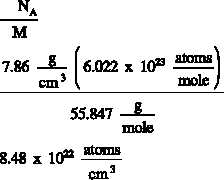'
(
)
DOE-HDBK-1019/1-93
Reactor Theory (Neutron Characteristics)
NUCLEAR CROSS SECTIONS AND NEUTRON FLUX
Rev. 0
Page 11
NP-02
Calculation of Macroscopic Cross Section and Mean Free Path
Most materials are composed of several elements, and because most elements are composed of
several isotopes, most materials involve many cross sections, one for each isotope involved.
Therefore, to include all the isotopes within a given material, it is necessary to determine the
macroscopic cross section for each isotope and then sum all the individual macroscopic cross
sections. Equation (2-4) can be used to determine the macroscopic cross section for a composite
material.
*
= N ) + N ) + N ) + ....... N )
(2-4)
1
1
2
2
3
3
n n
where:
N
= the number of nuclei per cm of the n element
n
3
th
)
= the microscopic cross section of the n element
n
th
The following example problems illustrate the calculation of the macroscopic cross section for
a single element and for combinations of materials.
Example 1:
Find the macroscopic thermal neutron absorption cross section for iron, which has a
density of 7.86 g/cm . The microscopic cross section for absorption of iron is 2.56 barns
3
and the gram atomic weight is 55.847 g.
Solution:
Step 1:
Using Equation (2-1), calculate the atom density of iron.
Step 2:
Use this atom density in Equation (2-2) to calculate the macroscopic
cross section.



